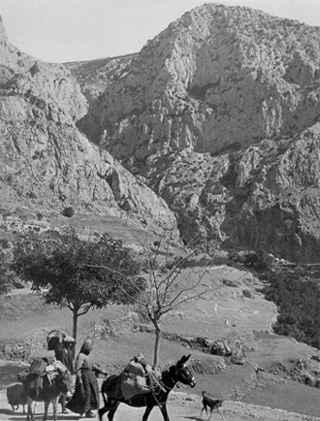
Printed works include the Maurice Holmes Collection of Pacific Voyages of Captain James Cook and the Francis P. Farquhar Collection of Mountaineering Literature. Map collections include the Stuart de Rothesay Collection (1715 - 1840), the Richard C. Rudolph Collection of Japanese maps (1614 - 1896), and California and Los Angeles area maps (1870 - 1930).

Francisco Palou, 1723 - 1789. Relacion historica de la vida y apostolicas tareas del venerable padre fray Junipero Serra, y de las misiones que fundˇ en la California Septentrional .... Impresa en MÚxico, en la imprenta de don Felipe de Z˙˝iga y Ontiveros, 1787. F 864 S4P1
 |
Adelbert Bartlett. Delphi, Greece, the lower slopes of Mt. Parnassus. Black and white photograph, scanned copy, enlarged. 1930s? Also postcards sent from Athens to his wife. 1930s? In: Bartlett, Adelbert, 1887 - 1966. Papers, ca. 1922 - 1950. Collection 1300. Box 37 f.1 Bartlett's note: "The lower slopes of Mount Parnassus, sacred to the poets of all time, rise precipitously from the precincts of ancient Delphi, which today lie in ruins at the left side of the view. The brook Castalia, which pours in a roaring torrent down from the higher slopes of Mount Parnassus crosses the view diagonally beneath the crags at right. Peasants with donkeys loaded with olives and fruits on the way to market are passing on the road in the foreground." Bartlett evidently had his studio in his home on 26th Street in Santa Monica, north of Montana Avenue. The papers include postcards to his wife from Athens, Greece, for example, these which show the The Clock of Andronikos Kyrrestos (Tower of the Winds, Plaka area) and the Monument to Philopappus (Philopappus Hill or Hill of the Muses). |
E. M. (Edward Morgan) Forster, 1879 - 1970. Alexandria: A History and a Guide.Alexandria: Whitehead Morris Limited, 1922. Special Collections SRLF. Also shown: Garden City, N.Y.: Anchor Books, 1961. A Doubleday Anchor original, A231. Special Collections SRLF
Henry Miller, 1891 - . The Colossus of Maroussi. San Francisco: Colt Press, c1941. With author's autograph. Special Collections SRLF. Also shown: [New York: New Directions, 1958, c1941]. A New Directions paperbook no. 75. Special Collections SRLF
N[ick] Stournaras. AntinoŘs. The Favorite of the Emperor Hadrian [black and white photograph printed as post card]. Athens, Greece: ca. 1966. To be added
Lawrence Durrell. A Landmark Gone. Los Angeles, 1949. Privately printed. 125 copies printed by Reuben Pearson with the author's permission for the friends of Lawrence Clark Powell. First published in Middle East Anthology, London, 1946. "A note on Lawrence Durrell," signed L.C.P. [i.e. Lawrence Clark Powell]: p.[i]-ii.
This description of Durrell's life on the island of Corcyra (Kerkyra or Kerkira, more commonly known as Corfu), ends with his escape to Egypt and Alexandria as World War II is beginning: "The day war was declared we stood on that balcony in a green rain falling straight down out of heaven onto the glassy floor of the lagoon; we were destroying papers, drawings, packing books. ... Last April as I lay in pitch darkness on the packed deck of a caique as we nosed past Matapan towards Crete, I thought back to that balcony in Corcyra, that green rain in the shadow of the Albanian hills. I remembered it all with a regret so deep that it did not stir the emotions; seen through the transforming lens of memory the past seemed so enchanted that any regret would have been unworthy of it."
Powell printed this work and notes at the end of his introduction: "Southern California is a fitting place for these glowing pages to be set again in type for it has an ambience akin to Corfu's -- a land of olive, oleander, lemon and hibiscus, seasonal rain and much sun." This was, as he noted later, "before industrial smog" in California.
This memoir uses in a slightly different form the last paragraphs of Durrell's book Prospero's Cell: A Guide to the Landscape and Manners of Corcyra, first published by Faber & Faber in 1945.
Durrell would later say of his and Miller's writing about Greece and Corfu in a typed letter not at UCLA (written from Belgrade 21 Dec no year): "I wish we'd never written those books and helped to start a fashion in Greece ... ."
 |
References |
References |  |
